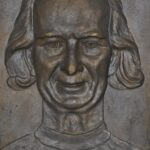
Aleksandravičius Antanas
Antanas Aleksandravičius (1885–1970), along with a small group of contemporaries—Petras Rimša, Juozas Zikaras, and Rapolas Šklėrius—laid the foundations of professional Lithuanian sculpture. Aleksandravičius dedicated his entire life to this cause, from early youth to old age, never letting go of the sculptor’s tools.
He was an artist of extraordinary diligence and devotion. Art historian Ona Mažeikienė aptly stated:“Through his remarkable work ethic, Aleksandravičius earned his place in the history of Lithuanian art. His patriotic monuments instilled pride in the nation, while his portrait sculptures—busts, reliefs, and coats of arms—hold significant iconographic value. All his portrayed subjects are highly recognizable. His relief portraits were often used to illustrate articles even during the Soviet era—unfortunately, often without crediting the sculptor.”
It’s surprising he wasn’t exiled to Siberia, considering he sculpted multiple reliefs of President Antanas Smetona, busts of Jonas Basanavičius, and monuments like The Angel of Freedom in Alytus and the six-meter-tall Pietà in Aleksotas Cemetery. The latter included plaques engraved with the names of fallen Lithuanian volunteers and a U.S. Army lieutenant, S. Samuel J. Harris, who died alongside Lithuanians during the liberation of the Aleksotas airport from Bolsheviks on February 23, 1920. Unsurprisingly, the 1976 edition of the Soviet Lithuanian Encyclopedia only spared Aleksandravičius a few lines—and omitted his photo entirely.
Born on December 3, 1885, in Gluosnininkai village near Simnas, Alytus district, Antanas was one of ten children. Even as a child herding animals, he sculpted clay figures, carved wood, and drew with charcoal. Orphaned at a young age, he was taken under the wing of his brother Alexander’s wife, Marija, who recognized Antanas’ artistic talent and took him to folk artist Matas Kasiulis in Krosna. There, he studied for over two years, learning woodworking, drawing, and gilding. Marija, from the noble Krašeuskis family and an artistically inclined woman herself, paid 80 rubles—a significant sum at the time—for his studies. Aleksandravičius remained forever grateful to her.
At age 18, he moved to Suwałki to apprentice with renowned church craftsman Adomas Karalius, specializing in altar carving. Between 1901–1905, they traveled across churches in Lithuania and Poland—Leipalingis, Studzienica, Piotnica, and others. During this time, Aleksandravičius met Bolesław Szeptkowski, owner of a religious art workshop in Warsaw, who urged him to study art formally. At age 20, Antanas enrolled at the Museum of Applied Arts in Warsaw.
While in Warsaw, he lived with the poet Ksaveras Sakalauskas-Vanagėlis, thanks to his cousin, priest and composer Vincas Aleksandravičius. The poet treated him like a son. But when conscription into the Tsarist army loomed, Sakalauskas-Vanagėlis advised him to flee to America. With the help of the Lomża Lithuanian Aid Society, Antanas left for the U.S. in 1906, joining his brothers and former mentor Kasiulis.
In 1907, he began sculpture and drawing studies at the Art Institute of Chicago. Professor Milligan, impressed by his talent, helped him land work at a prominent religious sculpture company, where he created a nearly 2.5-meter-high Nativity of Christ relief and a Christ statue. In his fourth year, he sculpted reliefs of Lithuanian dukes Gediminas and Kęstutis, and a Vytis emblem.
After completing his studies in Chicago, he returned to Europe and eventually back to Lithuania. He created a relief of Bishop Antanas Baranauskas and studied at the Imperial Academy of Arts in St. Petersburg from 1911 to 1918, focusing exclusively on sculpture.
In 1913, Aleksandravičius and priest Povilas Jonuškevičius founded an applied arts school in Kaunas named The Infant Jesus. He taught sculpture, drawing, and casting until World War I. In his free time, he created busts of pedagogue Tomas Žilinskas (installed in Veiveriai, 1931), composer Stasys Šimkus, priest K. Prapuolenis, and Lithuanian nobles Vytautas and Kęstutis. He also sculpted a relief and tombstone for linguist priest Kazimieras Jaunius in Kaunas Cemetery.
A devoted admirer of poet Maironis, he sculpted the poet’s bust and profile in 1914. In 1918, he met Dr. Jonas Basanavičius in Vilnius, whose noble appearance deeply inspired him. He would go on to create dozens of Basanavičius busts and reliefs—many of which still stand in places like Kaunas (Panemunė) and Birštonas.
In 1921, while teaching at Rygiškių Jonas Gymnasium in Marijampolė, he sculpted Pope Benedict XV’s profile, a Vincas Kudirka relief with the Lithuanian anthem, and a group composition titled Glory to You, Warriors. He also crafted five capitals for Sintautai Church, which was later destroyed in the war.
In 1928, he began work on the now-famous Angel of Freedom monument in Alytus—a 13-meter-tall structure featuring a 4-meter bronze angel and side reliefs, including one depicting the death of officer Antanas Juozapavičius.
During Lithuania’s interwar independence, Aleksandravičius created over 600 original sculptures, including portraits of prominent intellectuals, politicians, and clergy, as well as numerous city and town coats of arms. He remained a bachelor for much of his life, devoting himself entirely to the noble art of sculpture. For him, work was peace, hope, and joy.
His daughter Ramunė Korsakienė, with help from kind supporters, published a book for his 120th birth anniversary titled Ars longa, vita brevis—his favorite motto: “Art is long, life is short.”
Those who knew him said he was always guided by religious art and the moral clarity he gained from lifelong friendships with clergy like Maironis and Vaižgantas. He once said:“A work of art, as the highest expression of the human spirit, always brings us closer to God.”
Having seen much in life, the greatest blow came in the summer of 1940, when Soviet forces occupied Lithuania. The invaders shut down all national organizations and seized the Neolituanų Palace in Kaunas, where Aleksandravičius had lived for years. The halls and vestibules were adorned with his busts and coats of arms—a national artistic treasure.
Soviet soldiers arrived, mocked the national and religious themes of his sculptures, and destroyed everything. In his memoirs, Aleksandravičius recounted the loss of 8 sculptural groups, 21 figures, 73 busts, and 142 reliefs. He was devastated and contemplated suicide.
Antanas Aleksandravičius passed away on February 4, 1970, and was buried in Petrašiūnai Cemetery.



